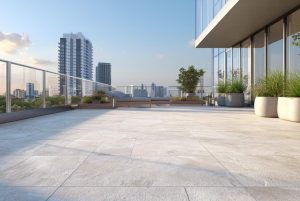Among the different types of flooring for decorating the interior and exterior of a home, hydraulic tiles are currently one of the best options. They offer strength, durability, and a remarkable aesthetic appeal that enhances any home. Furthermore, they are easy to maintain and do not require constant or demanding maintenance.
For these reasons, understanding what a hydraulic tile is is essential when planning home renovations. Below, we'll explain everything you need to know about this type of flooring and how it can benefit your home.
Origin of hydraulic tiles in Spain
Hydraulic tiles originated in France during the transition period between the pre-industrial and industrial eras. However, they arrived in Spain thanks to the manufacturer Francisco Garreta in Barcelona, who initially attempted to obtain exclusive rights.
Over time, these floors gained popularity throughout the country due to their low cost and easy maintenance. In 1873, the first hydraulic mosaic factory was established in Barcelona, boosting their artistic value, especially during the Modernist movement.
To fully understand what a hydraulic tile is, it is essential to understand its origin and evolution, as it provides context for the decorative and functional value these floors offer.
Materials and manufacturing process of hydraulic tiles
The manufacturing process for hydraulic tiles requires precision and care. Molds are used that include layers of sand, marble, cement, and other components. All of this is compacted using a hydraulic press to form the product.
Understanding these steps is essential to understanding what a hydraulic tile is, although it's also important to keep in mind that the design is completed by filling it with powdered pigment mixtures and compacting it again using pressure.
Hydraulic tile: features and advantages
Durability and wear resistance
Their robust construction provides excellent durability, allowing them to withstand the test of time, high temperatures, impacts, and frequent traffic. This makes them ideal for both indoor and outdoor use, maintaining their appearance for years.
Variety of designs and customization possibilities
When you research what a hydraulic tile is, you discover endless decorative possibilities. There are multiple styles available, and some manufacturers allow you to customize the design, allowing you to add a unique touch to any room.
Sustainability and ease of repair
Hydraulic tiles are a sustainable option. Their manufacturing process is low-polluting and environmentally friendly. They are also easy to repair in case of cracks or minor damage, making them a practical long-term solution.
Disadvantages and care of hydraulic tiles
Knowing what a hydraulic tile is also means understanding its weaknesses and the care required to prolong its lifespan.
Porosity and preventive sealing
The porosity of this type of flooring can affect its appearance over time. Therefore, it's important to perform preventive sealing. This process involves applying a sealant to the surface to protect it from stains and moisture.
Recommended cleaning and periodic maintenance
It's recommended to clean the tiles regularly with a slightly damp mop or cloth. It's best to avoid harsh chemicals unless specifically directed by the manufacturer.
For its preservation, waterproofing treatments, waxes, and sealants can be used. It's also advisable to periodically check the condition of the floor to apply the most appropriate treatment.
Applications of hydraulic tiles
This type of flooring offers great versatility within the home. By learning what a hydraulic tile is, you'll better understand its many uses.
Use on interior floors
Cement tiles are perfect for interiors due to their aesthetic appeal and durability. They add personality and warmth to the decor, while maintaining their quality over time.
Exterior cladding: terraces and common areas
Thanks to their resistance to adverse weather conditions, they can be placed on terraces, patios, or communal areas. They require little maintenance and allow you to customize outdoor spaces without sacrificing functionality.
Integration with polishing and vitrification to enhance the finish
One advantage of knowing what a hydraulic tile is is being able to take advantage of its compatibility with techniques such as polishing or vitrification. These improve the finish, offer a long-lasting shine, and reinforce the floor's durability.
Frequently asked questions about hydraulic tiles
Are they suitable for humid and outdoor spaces?
Yes, thanks to their resistance to moisture and temperature changes, hydraulic tiles are perfectly suitable for outdoors and wet areas. Furthermore, their variety of designs facilitates aesthetic integration into any environment.
How does heavy traffic affect its surface?
They can withstand daily traffic, although they require some care to prevent accelerated wear. By understanding What is a hydraulic tile?, it is also important to choose patterns and finishes that promote durability.
Can hydraulic tiles be polished and vitrified?
Yes, polishing and vitrification provide an additional protective layer, ideal for prolonging the lifespan of these tiles. These treatments improve their durability and maintain their uniform, glossy appearance.
At Projectes Sastre we are specialists in polishing and vitrifying hydraulic tiles.
The unique qualities of cement tiles make them an excellent choice for any home. However, they do require proper maintenance to maintain their beauty and functionality over time.
At Projectes Sastre, we offer professional polishing and vitrification services for hydraulic tiles in Mallorca . Contact us for a quote and to learn more about how we can help you keep your floors in perfect condition.




